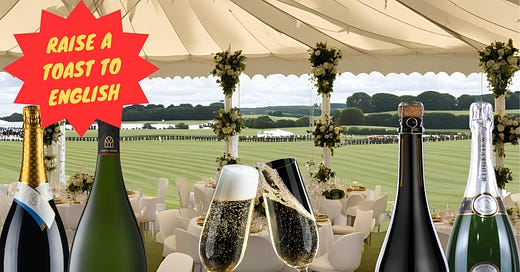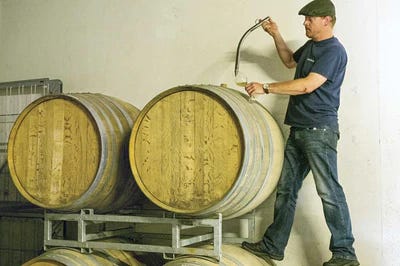How can English sparkling wine attract more drinkers?
Champagne rules at many summer sporting events - and this could be a problem
A news item caught my eye recently that got me thinking about the current state of the British wine industry. The story revealed that Ridgeview, based in East Sussex, has been named official English sparkling wine supplier for the Goodwood Estate, which consists of 11,000 acres nestled in stunning Sussex Countryside that includes a racecourse, a country house, a motor racing circuit, a hotel and a golf course.
Visitors seeking refreshment will be able to sample three of Ridgeview’s portfolio, the Bloomsbury, Fitzrovia and Blanc de Blancs – the last-named being served at the first state banquet of King Charles III.
However, will Goodwood visitors opt for Ridgeview over champagne, specifically Veuve Clicquot – the ‘grand marque’ that Goodwood traditionally offers – to mark a special day out in summer?
I suspect the majority would choose champagne, and this is one of the problems the British wine industry faces: how to persuade consumers to switch to English sparkling and away from a brand that has become the customary go-to beverage for a celebration.
In 2023 the UK guzzled its way through 25.2 million bottles of champagne, and
pre-2008, before the financial crisis when Lehman Brothers was still in business, this figure was 39.1 million (source, Comité Champagne). Compare these figures to the 6.2m bottles of British sparkling wine1 sold (including exports) in the same year and you get an idea of the huge gulf between champagne and British sparkling wine.
Of course, the Champagne region produces more wine. Its vineyard area is a massive 34,000 hectares compared to 4,209 hectares (2023 figures) for the whole of England and Wales. There will never be a time when more British fizz is sold in the UK than champagne, but in order for many producers to survive in the long-term, more homemade sparkling needs to be consumed.
It could be argued that the British wine industry is on an upward trajectory. The effects of climate change mean grape growing is a far more viable enterprise than it used to be because, owing to increased temperatures, grapes ripen more reliably, resulting in better-defined fruit flavours and an absence of underripe or tart characteristics.
Additionally, many English vineyards are situated on calcareous, chalky soils also found in the Champagne region, soil with good drainage properties to counter wet spells and cool temperatures to help maintain acidity and ensure slow, gradual ripening.
The conditions exist for making excellent-quality sparkling wine (probably less so for premium still wine), and it’s no surprise Champagne giant Taittinger acquired land in Kent for grape-growing in 2015. Domaine Evremond, the resulting partnership between Taittinger and British distributor Hatch Mansfield, is set to release its first sparkling English cuvee in spring 2025. Overseas investment has also come from further afield, with Cava giant Henkell Freixenet purchasing Bolney Wine Estate and California’s Jackson Family Wines planting new vines in Crouch Valley in Essex.
Recent sales figures are also encouraging. England and Wales wine sales have grown by ten per cent since 2022, and since 2018 sales of sparkling wine have increased by 187%. Exports also rose to eight per cent of total sales, while on-trade sales (for example, in pubs and restaurants) grew to 28 per cent of total production (from 22 per cent in 2022).
Given this growth, is there an urgency to convert more consumers to British sparkling wine, to persuade them that Nyetimber’s Blanc de Blancs, Dermot Sugrue’s The Trouble With Dreams or Chapel Down’s Kit’s Coty range (to name but three excellent-quality English sparkling wines) is on a par quality-wise with champagne at a similar price range?
I would suggest there is, particularly following a bumper 2023 harvest in England and Wales, leading to a record production of 161,960 hectolitres, equivalent to 21.6 million bottles, representing a percentage rise of a huge 77 per cent compared to 2022. When viewed in relation to these figures, that sales growth of ten per cent since 2022 doesn’t seem so encouraging after all. To meet supply, demand needs to grow, otherwise some producers will be left with unsold wine.
Harvests are variable, particularly in cool-climate countries such as England and Wales where excess rainfall can lead to mildew outbreaks, severely curtailing grape production. Given the indifferent summer we’ve been experiencing, this year’s harvest is unlikely to replicate 2023, but over the last five years average production has increased from 10.7 million to 12.4 million bottles2. And yet more British wine will be produced in the future, with total vineyard area expected to grow to 7,600 hectares in the next decade3.
To return to Ridgeview’s new partnership, it would be nice to think that last week’s five-day Glorious Goodwood horseracing festival provided the perfect opportunity to showcase the merits of British sparkling wine, not least because the racecourse lies in the heart of England’s wine region (Sussex was the first county to be earned PDO4 status).
Hopefully many of the thousands of racegoers who attended sampled Ridgeview’s fizz at its ‘Pavilion’ bar at the course, or at the various other bars, while watching the racing. However, it was somewhat disappointing that, according to the track’s website, of several upmarket hospitality options available to racegoers, only two, The Secret Garden and The Long View, provided an English sparkling wine reception. The others (including private boxes) serve the traditional ‘champagne and canapes’ reception and one, The Final Furlong, prosecco. Images on the website show racegoers enjoying Veuve Clicquot, rather than the local product.
This is one example where British sparkling wine needs more presence, something that also applies at Wimbledon, another marquee event. The epicentre of lawn tennis and the quintessential English summer sporting occasion doesn’t have an official partnership with a British wine producer but sells stacks of Lanson champagne.
More encouragingly, Henley Regatta has a deal with Nyetimber, and this year, for the first time in its history, Royal Ascot made Chapel Down its official English sparkling wine partner, but the Tenderden-based producer has a lot of ground to make up if its to match Moet & Chandon for exposure at that horserace meeting.
On a brighter note, wine tourism in England is thriving. Cellar door retail represents an impressive 17 per cent of total sales and, according to Nicola Bates, chief executive of Wine GB, visits to British wineries have doubled in the last two years5.
If they can double again, and if the government can be persuaded to offer concessions on cellar door sales of bottles, then that could be key to persuading more to drink British and, consequently, improving the chances of long-term survival for many producers.
Flight 28
Rathfinny Classic Cuvee 2019 (£12.50 a glass, Vagabond, retails for around £35)
Given the subject matter above, it seems appropriate to focus on English wines in this week’s flight. A blend of 44% pinot noir, 41% chardonnay and 15% pinot meunier, this has autumn orchard fruits with some toasty, brioche notes coming through on the finish. Quite lean (dosage is relatively low) and extremely refreshing – excellent choice for the first drink of the evening.
Vagabond Urban Winery English Rose (£18 takeaway price per bottle from Vagabond)
Made from 70% pinot noir and 30% pinot noir precoce, I enjoyed the smoky, toasty characteristics (as a result of some barrel ageing) that were evident here alongside the strawberry and red berry flavours typical for a rose. Something different and just 11.5% abv.
Simpsons Gravel Castle Chardonnay 2023 (£18 Wine Society)
Citrusy, with green apple and a flinty streak. Some brioche and toasty notes also evident from lees ageing but perhaps could do with being a bit more rounded to compensate for the high acidity. Good example of an English chardonnay though.
This, and all subsequent statistics (unless otherwise noted) for British wine sourced from WineGB
Statistic taken from an article on harpers.co.uk - UK Vineyards Surpass 1,000 as Wine Sales Rise 10%
From Harpers.co.uk article - Caution Advised on Overhyping English Wine ‘Boom’
‘Protected Designation of Origin’
From Harpers.co.uk article - Caution Advised on Overhyping English Wine ‘Boom’






Thanks for the recommendation George - I’ll check it out!
Can also recommend the sparkling form Forty Hall Vineyard, grown in London of all places! Serious quality.